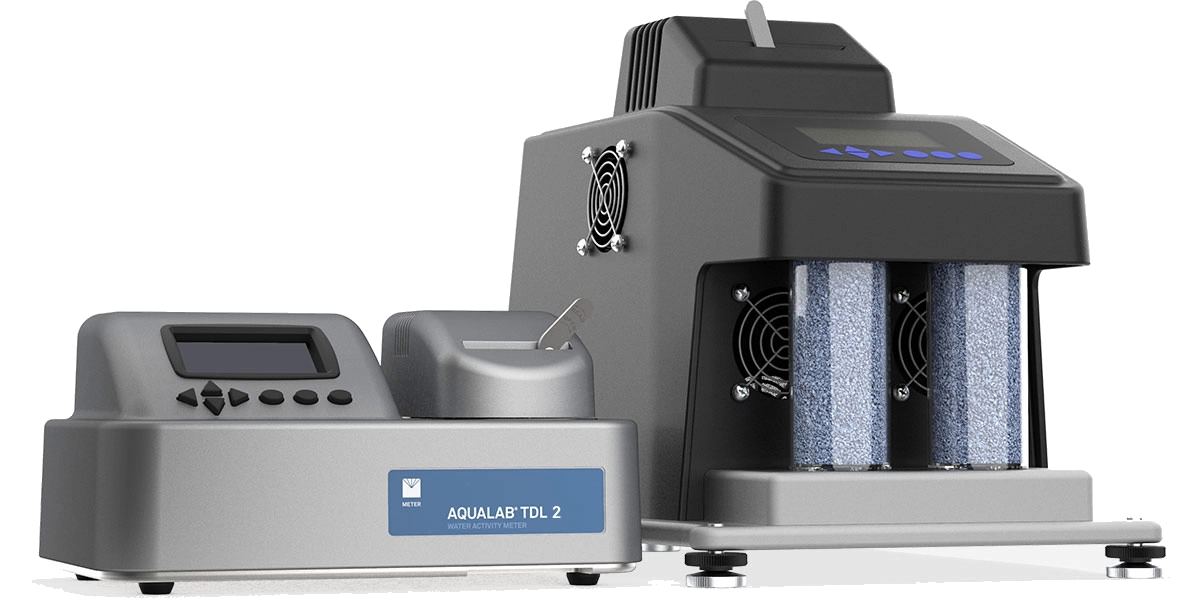微生物、耐热性与水分活度之间的关系

在低水分活度条件下,微生物细胞表现出增强的耐热性。关于这一主题,已有大量研究报告发表,尤其是针对沙门氏菌的研究,因为在低水分活度下,沙门氏菌的存活面临重大挑战。
下图展示了肠炎沙门氏菌(Salmonella
Enteritidis)PT 30的耐热性与水分活度之间的关系。实验在80°C下进行加热,同时使用二氧化硅颗粒作为载体,在一个特别设计的测试单元中控制相对湿度在18–72%之间。该图显示:随着水分活度的降低,沙门氏菌在80°C下的D值(即杀灭90%微生物所需的时间)增加。
对于对微生物加热和D值基础感兴趣的人,请参阅以下文章:
Food Heat Sterilization: Understanding and Applying
Pasteurization, D Values, and Z Values
上图是根据从以下论文中部分提取的数据重新绘制的:
不同低水分活度食品中微生物耐热性的增强
改变水分活度如何影响实际食品中沙门氏菌的耐热性?本节将介绍涉及花生酱、肉桂粉和杏仁粉的实例。
花生酱
花生酱的水分活度低于0.35,因此不支持细菌生长,按理说不太可能引起食物中毒。然而,在2006年至2012年期间,美国发生了多起与花生酱相关的沙门氏菌疫情,当时的奥巴马总统还在NBC的一档节目中批评了美国食品药品监督管理局(FDA)。
有关与花生酱相关的沙门氏菌中毒事件的更多详情,请参阅以下文章:
Cavallaro
E et al.,
Salmonella typhimurium infections associated with peanut products
N Engl J Med.2011 Aug 18;365(7):601-10. doi: 10.1056/NEJMoa1011208.
下图展示了在不同水分活度(0.2和0.4)条件下,鼠伤寒沙门氏菌(Salmonella
Typhimurium)在花生酱(含49%脂肪、24%碳水化合物)中经90°C加热后的数量衰减情况。该图表明,在较低水分活度(0.2)条件下,沙门氏菌的耐热性有所增强。
上图是根据从以下论文中提取的数据绘制的:
Increased
Water Activity Reduces the Thermal Resistance of Salmonella enterica in Peanut
Butter
Appl Environ Microbiol,79(15):4763-7( 2013 )
香料(肉桂)
有关肉桂等香料受到沙门氏菌污染的报道屡见不鲜。在2009年至2010年期间,美国44个州有272人因食用与受污染的黑胡椒和红胡椒相关的萨拉米香肠而感染沙门氏菌中毒。
有关此次疫情的更多详情,请参阅以下文章:
Nationwide
outbreak of Salmonella Montevideo infections associated with contaminated
imported black and red pepper: warehouse membership cards provide critical
clues to identify the source
Epidemiol. Infect. (2013), 141, 1244–1252.
下图展示了在不同水分活度条件下,肠炎沙门氏菌PT 30在肉桂粉中经75°C加热后的存活情况。随着水分活度的增加,肠炎沙门氏菌PT
30的log10 D值(即杀灭90%微生物所需时间的对数值)呈线性下降。
上图是根据从以下论文中提取的数据绘制的:
Thermal
inactivation of Salmonella Enteritidis PT30 in ground cinnamon as influenced by water activity and
temperature
Food control v.124 pp. 107935(2021)
杏仁
下图显示,与水分活度为0.888的杏仁粉相比,在水分活度调整为0.720的杏仁粉中,肠炎沙门氏菌的耐热性显著增强。
上图是根据从以下论文中提取的数据绘制的:
Thermal
Inactivation of Salmonella Enteritidis PT 30 in Almond Kernels as Influenced by
Water Activity
Journal of Food Protection 76(1):26-32(2013)
这项研究强调了温和巴氏杀菌处理生杏仁所面临的挑战,因为生杏仁在美国和欧洲已与多起沙门氏菌中毒事件相关联(美国疾病控制与预防中心,2004年)。
研究结果表明,在短时间、低温处理前增加杏仁的水分含量,可以有效地对坚果进行杀菌——这种方法可能也适用于其他干燥食品。
微生物的耐热性可能仅由加热时的水分活度决定,而非食物成分的差异
来自不同研究者的数据显示,即使在相同的水分活度水平下,不同类型的食物也会导致沙门氏菌的耐热性(D值)存在差异。这引发了人们的猜测,即食物成分可能会影响沙门氏菌在低水分活度条件下的耐热性。然而,最近的研究表明,这些差异是由加热过程中水分活度的变化所决定的。
本节将介绍一篇详细阐述水分活度对三种低水分活度食物(面粉、杏仁粉和乳清蛋白)中肠炎沙门氏菌PT30耐热性影响的论文。
所总结的实验方法如下:
本研究在三种食物中评估了沙门氏菌的耐热性,这三种食物分别是面粉、杏仁粉和乳清蛋白,它们分别代表了富含碳水化合物、脂肪和蛋白质的食物类别。
使用不同浓度的氯化锂(LiCl)溶液,在室温(约20°C)下将每种粉末状食物的水分活度调整至0.25、0.45、0.60和0.80。
选用具有相对较高耐热性的肠炎沙门氏菌PT30菌株进行接种实验,该菌株与国际上与生杏仁相关的疫情暴发有关。
将样品置于铝制容器中,在80°C下加热,并测量D值(即灭活90%目标细菌所需的时间)。
实验结果如下:
在所有粉末状食物中,当水分活度较高时,沙门氏菌均被迅速灭活。
在相同水分活度水平下,不同类型食物中沙门氏菌的灭活曲线几乎完全一致。
无论食物基质或测试方法如何,沙门氏菌在80°C下的D值均随处理温度下水分活度的增加而呈指数级下降。
在相同水分活度下,不同粉末状食物在80°C下的D值几乎相同。例如,在80°C下,水分活度为0.50时,杏仁粉和乳清蛋白的D值分别为24.9分钟和23.2分钟。
上图是根据从以下论文中提取的数据绘制的:
根据这些实验结果,得出以下结论:
不同食物导致沙门氏菌D值出现差异的原因并非食物成分本身,而是由这些食物成分在加热过程中引起的水分活度变化所致。
因此,沙门氏菌的耐热性仅由水分活度决定。
低水分活度下微生物耐热性增强的机制
研究已探讨了为何低水分活度会赋予微生物细胞更强的耐热性。以下概述了一些提出的关键假设机制。
热传导性
水是热量的优良导体。另一篇文章解释了湿热灭菌和干热灭菌在灭菌效率上的显著差异,详情请参见:
食品灭菌:掌握热灭菌的基本原理
对于低水分食品,多项研究已通过实验证明,随着水分含量的降低,热传导性也会下降。Tavman等人的研究调查了11种奶酪、4种酸奶和1种黄油的导热性。研究结果表明:
热传导性随水分含量的增加而线性增加,显示出非常好的相关性。
食品中的蛋白质含量增加时,热传导性会线性降低。
食品中的脂肪含量增加时,热传导性会线性降低。
上图是根据从以下论文中提取的数据绘制的:
Measurement of thermal conductivity of dairy products
Journal of Food Engineering 41 109-114(1999)
然而,值得注意的是,本文主要研究的是水分含量与热传导性之间的关系,而非水分活度。因此,直接将这些发现应用于低水分活度食品并不总是100%准确的。不过,对于许多在热灭菌过程中存在问题的低水分含量食品而言,考虑这些传导性差异通常是有意义的——除了像果酱这类高水分但低水分活度的食品之外。
蛋白质结构刚性化防止变性
当微生物细胞受热时,水分子开始振动,从而削弱并破坏周围蛋白质中的二硫键和氢键,导致蛋白质结构发生变化并发生变性。在高水分条件下,细菌细胞失活的主要原因是核糖体的不可逆性失稳,特别是30S和50S核糖体亚基的失稳,这一点已由Lee和Kaletunc(2002年)通过实验验证。
蛋白质三维结构的动态波动对于热变性是必要的,而这一过程需要足够量的水。
在低水分活度条件下,这些与蛋白质结合的水分子数量减少,导致蛋白质结构灵活性丧失。蛋白质灵活性的丧失意味着酶中的疏水位点在结构上变得僵硬并被掩埋,从而降低了它们在加热过程中暴露的可能性。因此,低水分活度使得酶难以失活。
芽孢杆菌等耐热菌种及其芽孢所具有的高耐热性,被认为是由于其蛋白质结构灵活性较低所致(Sunde等人,2009年)。
关于微生物在低水分环境中耐热性增强的各种机制已经进行了研究,但在此仅列出具有代表性的假设。
结论:干制食品灭菌时需谨慎
正如本文所讨论的,在热灭菌过程中,微生物在低水分活度环境下表现出显著增强的耐热性。因此,在对干燥或低水分活度食品进行加热处理时,必须格外小心,因为从液体介质加热实验中获得的D值可能无法直接应用。这就需要我们更加关注,以确保有效灭菌,同时不低估这些微生物的耐受性。

与我们交流水分的应用
您不必单独弄清楚新仪器如何适应您的工作流程。我们渴望听到您的目标并讨论我们如何提供帮助。提交此表格与专家交谈。